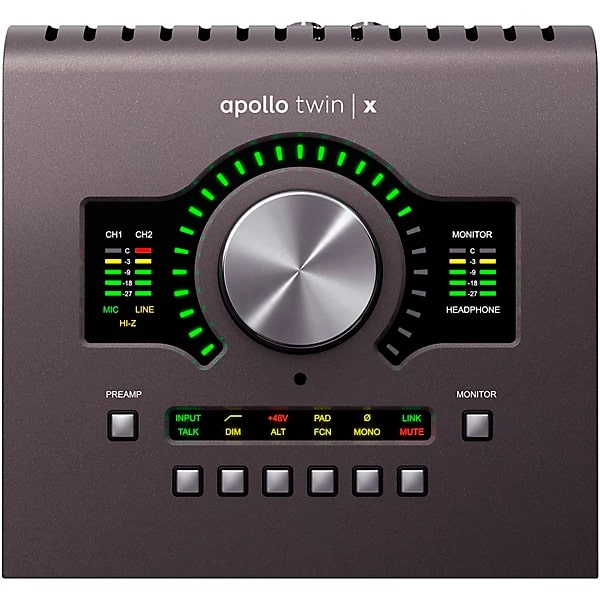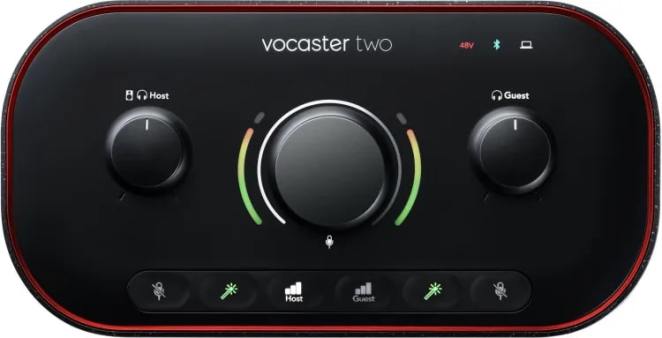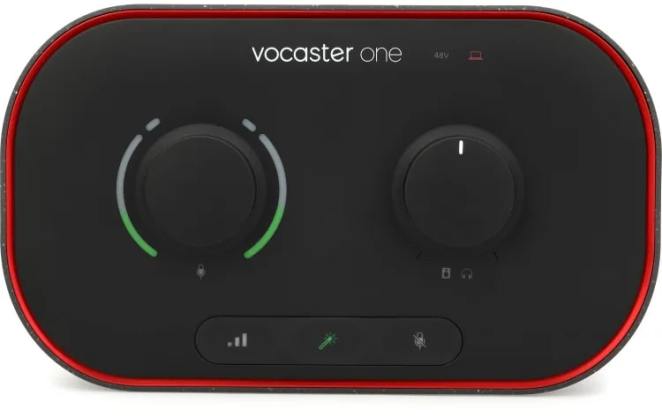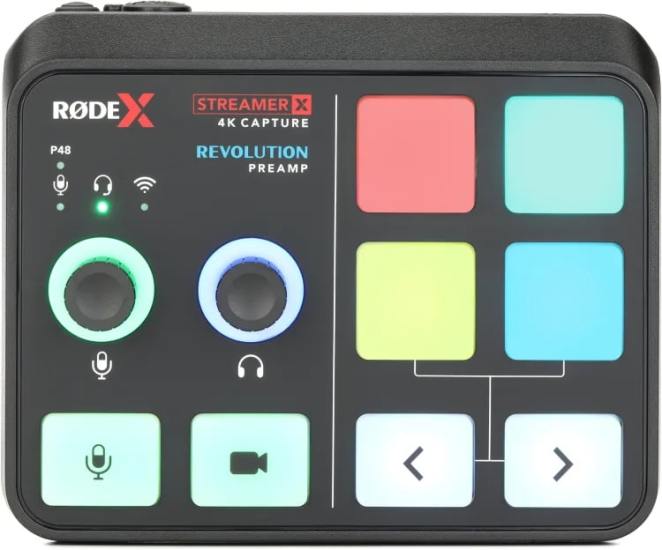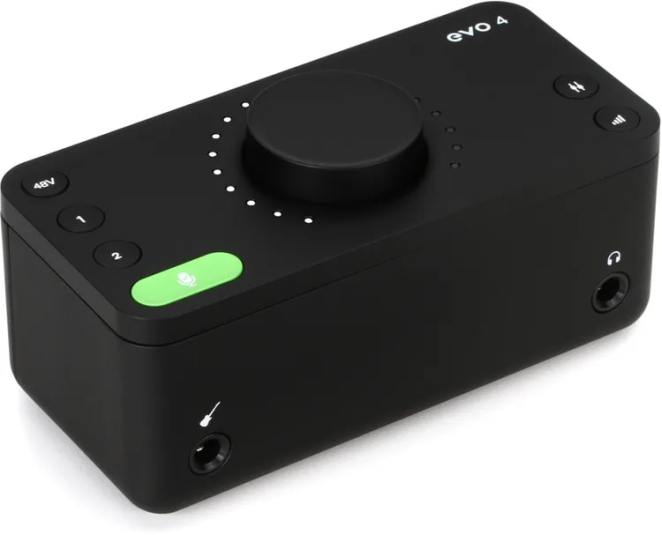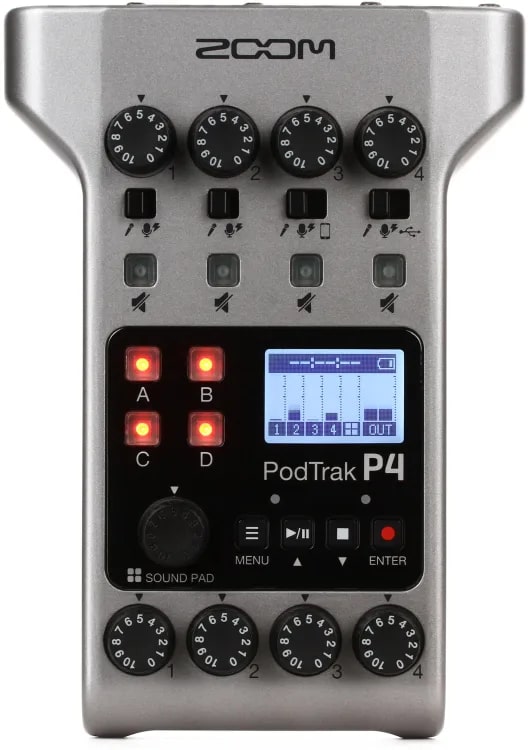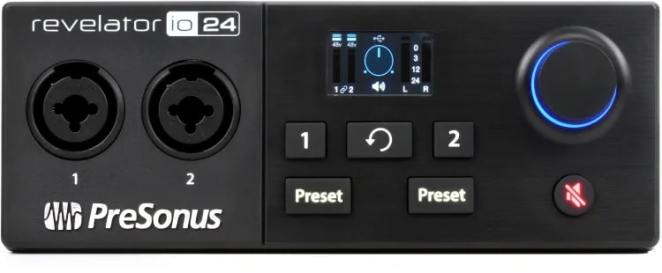When you buy through our links, we may earn an affiliate commission.
Creating and producing podcasts has become incredibly popular in the last couple of years. While it's easy to get started with a couple of microphones and a computer, an audio interface is what gives your podcast the production value it needs to succeed.
In this article, we've picked the best audio interfaces for podcasters with budgets high and low. We're also highlighting their best features and showing you how they can improve your pod. At the end of the article, we've also included a buyer's guide so you know what to look for while you're shopping.
Our #1 pick for the best overall audio interface for podcasting is the Focusrite Scarlett 2i2 for its affordable price tag, incredibly sleek design, and accurate Auto Gain feature. Keep reading to see if the Focusrite Scarlett 2i2 is the best audio interface for your podcast or if we found something better for you and your listeners.
Quick Summary of the Best Audio Interfaces for Podcasting
- Focusrite Scarlett 2i2 (Best Overall Audio Interface for Podcasting)
- Universal Audio Apollo Twin (Best Premium Audio Interface for Podcasting)
- Focusrite Vocaster Two (Best Audio Interface for Podcasting with Bluetooth Connectivity)
- Focusrite Vocaster One (Best Audio Interface for Solo Podcasting)
- Rode Streamer X (Best Audio Interface for Podcasting with Video)
- Audient Evo 4 (Simplest Audio Interface for Podcasting)
- Zoom PodTrak P4 (Best Audio Interface for Beginner Podcasters)
- PreSonus Revelator io24 (Best Budget Audio Interface for Podcasting)
Best Audio Interfaces for Podcasting
Best Overall
SPECS
- Number of Inputs and Outputs: 2 x 2
- Compatibility: ChromeOS, Mac, and Windows
- Headphone Outputs: 1 x 1/4"
What Could Be Improved
- There could be more inputs and outputs
The Focusrite Scarlett 2i2 is the most widely used audio interface in podcasting. It's easy to use, not hard on your budget and doesn't look too bad on screen for a visual podcast either. Most importantly, it gets the job done well.
Focusrite included a myriad of features in their Scarlett 2i2 that make producing a pod simple. They included a Clip Safe feature to protect your recording from unwanted clipping, Auto Gain to optimize your recording, and visible Dynamic Gain Halos so you can get an idea of your levels at a glance.
If you don't have a dedicated producer for your podcast (which is totally understandable), the Scarlett 2i2 is a great audio interface for you. It's simple to use and understand and the features we listed above will correct any mistakes you make before you even notice.
The Focusrite Scarlett 2i2 is our best overall audio interface for podcasting for a lot of reasons. It provides high-quality audio recording, has better features than most audio interfaces, and comes with two stereo inputs and outputs for quick connectivity.
Check out our review of the full Scarlett line to learn more.
Best Premium
SPECS
- Number of Inputs and Outputs: 10 x 6
- Compatibility: Mac and Windows
- Headphone Outputs: 1 x 1/4"
What Could Be Improved
- More podcast-specific features
- Lower price tag
The Universal Audio Apollo Twin stands out as a premium audio interface. It comes with an astounding amount of connections, features, and more to justify its higher price point. At nearly four times the price of our number one overall pick, the Apollo Twin is truly in a class of its own.
While the other audio interfaces on this list are focused on podcasting, the Apollo Twin can do much more. It provides producers with superior sound quality and elite-level audio conversion other interfaces can't hold a candle to.
Universal Audio's Apollo Twin allows you to hear every note in a playback, which may be a little bit more than some podcasters are looking for. If you want to have one of the most sonically detailed pods on the charts though, this audio interface will get you there.
While some may consider the Apollo Twin to be an expensive audio interface, we see the litany of benefits it brings to the table and consider it to be the best premium option on this list. If you want an interface capable of podcast and music recording, consider the Apollo Twin from Universal Audio.
Apollo Twin X or MKII? Find out which model best suits your needs in our full review.
Best With Bluetooth
SPECS
- Number of Inputs and Outputs: 2 x 2
- Compatibility: Mac and Windows
- Headphone Outputs: 2 x 1/4"
What Could Be Improved
- Not much
If the Apollo Twin from Universal Audio is the jack of all trades, the Focusrite Vocaster Two is the master of one—recording podcasts. The Vocaster Two has everything both a beginning and experienced podcaster could want from their audio interfaces.
The Focusrite Vocaster Two can handle two headphone outputs and two mic inputs at the same time, making it a great interface for podcasts with two hosts or one host and a guest. It's also less than $150 at the time of writing which is one of the more affordable options on the market.
Focusrite is known for their user friendly interface and the Vocaster Two is no exception. There aren't any frills are unnecessary features with this one. The Vocaster Two's Bluetooth connectivity is one of its stand-out features, allowing you to connect to your interface with a phone, computer, and more.
If you're looking for one of the best audio interfaces with a headphone jack, headphone output, mic input, and much more, the Focusrite Vocaster Two may be the audio interface for you. It handles popular recording software with ease and provides your podcast with the pristine audio quality it deserves.
Best for Solo Podcasting
SPECS
- Number of Inputs and Outputs: 1 x 2
- Compatibility: Mac and Windows
- Headphone Outputs: 1 x 1/4"
What Could Be Improved
- Could add a second headphone jack
If you couldn't tell by now, Focusrite makes some of the best audio interfaces around. From their impressive Scarlett 2i2 to their powerful Vocaster Two, we now have their compact and affordable Vocaster One, the perfect audio interface for solo podcasters.
As far as audio interfaces go, the Vocaster One's audio quality is second to none. It's only priced at $100 at the time of writing as well, making it one of the most affordable audio interfaces on our list today. While it could be considered a budget option, Focusrite included everything a podcaster needs to get their pod off the ground and rolling.
The Vocaster One comes with a mute button, Auto Gain feature, four voice presets, and a wide 70 dB gain range so you can record high-quality audio at different volumes. If you're a solo vlogger, plug the Vocaster One directly into your camera with a TRS cable and improve your production level in a click.
The Vocaster One is another one of Focusrite's astounding audio interfaces. It's the perfect versatile audio interface for the solo podcaster who wants to upgrade their equipment without breaking the bank or having to learn complicated hardware.
Best for Podcast w/ Video
SPECS
- Number of Inputs and Outputs: 1 x 1 x 1
- Compatibility: Mac and Windows
- Headphone Outputs: 1 x 1/4" TRS, 1/8" TRRS (headset)
What Could Be Improved
- More audio outputs
While we touched on recording video with a podcast through our last audio interface, the Vocaster One, the Rode Streamer X takes recording audio and video to a whole new level. Rode calls it their "all-in-one streaming solution" and it's not hard to see why.
The Rode Streamer X comes with a Revolution preamp to deliver excellent sound quality. It also comes with an HDMI streaming connection to transmit video at 4K resolution at up to 30 frames per second. With this interface, you're upgrading each part of your podcast.
The Streamer X comes with four programmable sound pads that can be used for sound effects or other effects on your computer. Rode also included two USB-C interfaces to allow for complete control once you connect the interface to your computer.
Most USB audio interfaces don't come with nearly as many facets as the Rode Streamer X. This audio interface is great for the podcaster who wants to add video to their pod or improve the quality of the video they're already getting. Get yours today to improve your next recording sessions.
Simplest for Podcasting
SPECS
- Number of Inputs and Outputs: 2 x 2
- Compatibility: Mac and Windows
- Headphone Outputs: 1 x 1/4"
What Could Be Improved
- Could be more ports
If you're looking for a simple USB audio interface with no frills, the Audient Evo 4 should be high on your list. This USB bus power interface is one of the easiest to use on this list, making it the perfect starter hardware for your podcast. Just because it's a great starter interface doesn't mean it's entry-level, as the Evo 4 has enough quality features to earn it a spot on our list.
The Audient Evo 4 handles analog audio signals with ease thanks to its intelligent mic preamps and advanced converter technology. If you're not sure what that means (and we don't blame you), it means the Evo 4 can not only manage your recordings but also give you the high-quality audio your listeners are looking for.
Audient has included a massive range of 113dB for the Evo 4's dynamic range. It also comes with a handy Smartgain feature that's perfect for solo podcasters who want some help making sure their audio recordings are clean and not clipping.
The Audient Evo 4 is one of our favorite audio interfaces for podcasting due to its high-quality preamps, XLR input, and - you guessed it - affordable price tag. At less than $150 at the time of writing, you can get one of the best USB audio interfaces out there and take your podcast up a few rankings.
Best for Beginners
SPECS
- Number of Inputs and Outputs: 2 x 2
- Compatibility: iOS
- Headphone Outputs: 4 x 1/4"
What Could Be Improved
- More aesthetic design
- Simpler interface
The Zoom PodTrak P4 is a great USB audio interface for a lot of different reasons. It comes with four XLR microphone inputs, four headphone outputs with individual volume control, and phantom power for all of its XLR tracks, giving you more options than many of the other audio devices on this list.
Beginning podcasters will want access to the myriad of features the PodTrak P4 brings to the table, including its mute button, programmable sound pads, and transport controls. They'll also enjoy the combination of access to both an external power source and batteries, allowing the P4 to be taken on the go.
Producers love the PodTrak P4 because of its ability to record each microphone input separately. This is perfect for a podcast that requires a lot of post-production work to make sure it is producing high-quality audio.
If you're just getting into the podcast game and want the best beginning USB audio interface, we think the Zoom PodTrak P4 is the choice for you. Its ability to handle multiple microphones, independent volume control, and XLR inputs will keep it in your setup for years.
Best Budget for Podcasting
SPECS
- Number of Inputs and Outputs: 2 x 4
- Compatibility: Chrome, Mac, Windows
- Headphone Outputs: 1 x 1/4"
What Could Be Improved
- Not a lot of options
- Might be too simple for some
If you're worried about having to spend an arm and a leg just to get your podcast up and running, meet the PreSonus Revelator io24, the best budget audio interface for podcasting. It's the most affordable interface on this list at less than $100 and it still comes with enough great features to seriously improve your pod.
Podcasters will find the vocal processing onboard to be extremely useful as the Revelator io24 is always working to make sure you sound your best. It also comes with easy-to-read meters so you can check your levels with a glance.
We love the app control that comes with the PreSonus Revelator io24. You can get the most out of it from your phone or tablet, allowing you to tinker with a bunch of different controls until you can find the right audio inputs for your podcast.
While setting up a new podcast can be expensive, it doesn't have to be. The PreSonus Revelator io24 is the perfect example of a quality interface anyone can get without overspending. It comes with a lot of great features that make it a fierce contender with any other audio interface, expensive or not.
Best Audio Interfaces for Podcasting Buyer's Guide
When you're looking for an audio interface for your podcast, there are a couple of key features you need to pay attention to. Some of the most important features that can decide whether an audio interface is right for your podcast include the number of inputs and outputs, what the interface is compatible with, if you need it to be portable, and what additional features it may come with.
Inputs and Outputs
The amount of inputs and outputs an audio interface has is very important for your overall purchase. If you plan on doing a podcast with four people on microphones but only have two inputs, it can be detrimental to your audio quality.
Make sure the amount of inputs and outputs an interface has reflects the number of people you want on microphones for your podcast. If you're doing a solo podcast, you probably don't need as many as a group podcast would.
Compatibility
Whenever you buy new audio equipment you'll want to make sure it's compatible with your current setup. Before you buy a new USB audio interface, make sure it works with whatever recording software you use so that you don't lose any sound quality.
Most websites selling audio interfaces will let you know what they're compatible with.
Portability
Most podcasts are recorded in a studio with equipment that doesn't move much after it leaves the box. If you want to get high-quality audio on the go, however, you'll want to make sure that the audio interface you're looking at is portable.
Portability in the world of interfaces is more than its weight - it's the ability to be used on the road. The Audient Evo 4 is a great example of this due to the interface's reliable sound quality, durable and lightweight design, and strong audio signal.
Added Features
The best USB audio interface will come with the features your podcast is looking for, including mute buttons, programmable sound pads, an instrument input, phantom power, and anything else you could want. USB interfaces are well-known for their versatility, so take advantage of their features and find the right, quality audio interface for your podcast.
Frequently Asked Questions (FAQs)
What types of microphones are compatible with audio interfaces?
Most audio interfaces support a wide range of microphones, including dynamic and condenser microphones. Make sure the interface provides phantom power if you're using condenser microphones. A USB microphone or a podcast microphone may work as well.
Can I use this interface with my specific recording software? (Audacity, Adobe Audition, GarageBand)
Check the interface's compatibility with your recording software before you make your purchase. Most interfaces work with popular DAWs like the three listed above.
Is this interface compatible with my computer's operating system?
Just like making sure your recording software is compatible with your new interface, you should always check to ensure your operating system is compatible as well. Most interfaces work with Windows and Mac devices.
Does this interface come with any bundled software or plugins?
Some interfaces come with bundled software or plugins, which can enhance your recording and editing capabilities. Check the product details for any included extras.
Does this interface require external power or is it bus-powered?
Some interfaces are bus-powered, drawing power from your computer's USB or Thunderbolt connection, while others require external power. Some interfaces use phantom power internally as well.
Conclusion
The right audio interface can take your podcast to new heights, turning a casual sit-down conversation into a high-quality audio recording. Finding the perfect interface for your podcast is essential as well, and you can narrow your search by looking at an interface's microphone inputs, overall audio quality, portability, and any additional features it may come with.
If you want the best overall high-quality audio interface for your podcast, we recommend the Focusrite Scarlett 2i2 for its reasonable price tag, high-quality audio recording, and compatibility with just about any digital audio workstation.
If you're a solo podcaster, you might like the Focusrite Vocaster One instead.

